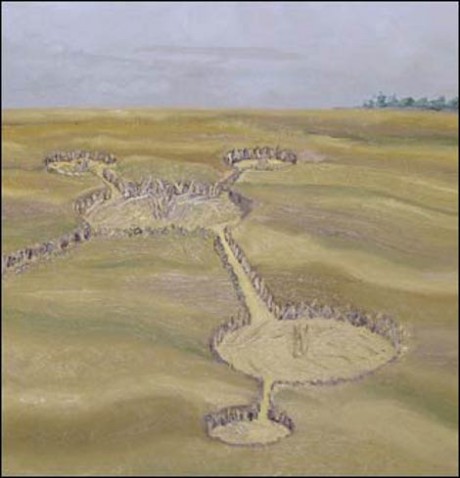 Wer sich ein wenig in der Welt der Alternate Reality Games umschaut wird ihren Namen bereits gelesen oder zumindest gehört haben.
Wer sich ein wenig in der Welt der Alternate Reality Games umschaut wird ihren Namen bereits gelesen oder zumindest gehört haben.
Bekannter ist sie jedoch unter dem Namen imbri, unter dem sie auch in den Unforums zu finden ist. Ohne vorab zu viel von ihren Antworten vorweg zu nehmen, stellen wir ihr diese Woche die 15 Fragen…
1) About when and how did you get in touch with ARGs?
Back in the spring of 2001, I was pointed to the Cloudmakers Yahoo! Group while working on a study of online communities. It immediately fascinated me, not because of the game behind it, but because of the way in which people from all over the world were coming together to work through a complex series of problems. The ARG was intriguing, but I had deadlines to meet for my research and graduation. After those were met, I found myself with a bit of free time and headed back to Cloudmakers community to see if I could make a bit more sense of what all was going on. It must have been fate that shortly after that a message was posted suggesting that the players form a group to create their own game. I joined the group not because I wanted to participate in the creation process but because I wanted to observe it. I figured that it would offer some great research potential – how do online communities differ when they’re solving a fictional mystery and when they’re creating that mystery. Though, things never work out as planned and within a few weeks I found myself as one of the core developers. Once the game went live, I was hooked and my career path was forever changed.
2) Did you take part in some ARGs as a player, too? Which?
This is a hard question to answer. I’ve observed a number of games and participated in a few of them. However, I would say that only Last Call Poker has taken me completely away from the observer role and made me an active player. Part of it was that I had more time to get involved, but most of it was the story combined with the live events and special favors. I really became immersed in that game.
3) In which ARGs have you been Puppetmaster/BHTS and what was your job in those?
I’ve worked on a number of games, though most were for private clients as corporate training exercises. Publicly, I’ve worked on Lockjaw and Metacortechs as a designer & writer and on Who Is Benjamin Stove as a writer.
4) Which ARG do you like best and why?
That’s like asking someone who their favorite child is. They each have their own personality, strengths, and weaknesses. Though, Last Call Poker did capture my attention unlike any other. Though it didn’t achieve the player base that I thought it deserved (millions and millions!), it was a very well designed game that took into account so many different player types – those that enjoy the social aspects were given as much thought and consideration as those that enjoy the puzzle or story aspects. Additionally, it was designed in a way so that you could get satisfaction from the experience if you had ten minutes to devote to it or forty hours.
5) Which was the funniest/nicest happening while doing/playing an ARG?
So many things come to mind, every game has moments to remember. The things that I tend to remember most are things that we, as designers, had little to do with. The spontaneous parties in the player chatroom for Lockjaw, the photoshopping of characters in Metacortechs and Who Is Benjamin Stove. Seeing the players so actively engaged with something that you had a hand in creating to the point where they are creating their own content and fun is my favorite part of any game.
6) Are there any memories to happenings that you wanted to forget about?
I don’t like to forget things, even the bad ones, as there is always something to be learned from it. And, with every bad, there is some good to be gained. For example, in Metacortechs (a game in the Matrix universe that was a bit attractive to hackers) our server was compromised through a relatively simple exploit that we had overlooked. Fortunately, they didn’t really know what they were doing and we were able to patch it quickly – no harm came to the game and there was never a risk to any confidential information (such as email addresses). However, in doing so, they learned that we were the team behind it. Until that point, most of the players were still debating on whether it was an official game for the series or whether it was fan-fiction. So, while we were all quite upset at first that the mystery of who was behind it was solved, solving it let the players move beyond that debate and become more fully engaged with the story.
7) How do you explain ARGs to your family / friends / relatives and how do they react?
I usually start of by explaining that it’s a new twist on storytelling. Unlike television or radio or even the horror story told over a campfire, in Alternate Reality Games, the story has been broken up into lots of little pieces and scattered around. They pieces might be video clips or text or audio files. They might even just be an object. They may show up online, on your voice mail, or even at that really cool statue in town. So, together with all sorts of people, you go out and gather all of these pieces and put together the story. And, the coolest thing about it all is that while you’re putting the story together, you actually have influence on it. So, you might be able to chat with a character or affect whether a character lives or dies.
8) Which 3 things does an ARG really need to have, to be a good ARG in your opinion?
The first and most important thing that an ARG needs is a story. Without a story, the ARG cannot exist. The next thing that an ARG needs is good communication between the players and the developers. The third must have is a solid game design that helps to keep players engaged with the story while facilitating the communication between the players and developers.
9) Do you have a favourite character from an ARG?
Wow, so many good characters to choose from. I think that my favorite was Brutus who was, actually, a house AI in the Beast. He had such a great sense of humor and compassion. You know, for a house and all.
10) What are you currently working on? (if you may tell us/are allowed to tell us 😉 )
Oh, I wish I could tell you all about all the exciting things going on right now. I will say that, if everything goes as planned, it’s going to be a very busy and very fun 2007.
11) Which puzzle from past ARGs do you like best/was real fun? Can you tell us why?
My favorite puzzles are those that truly offer a lot to the story, both in their design and in what they reveal. I also like complex puzzles and those that bring the community together, yet could be solved on your own. And, while I create dozens of smaller puzzles, puzzles that do all of that are my goal. And, of those puzzles, the Seven Sins puzzle in Lockjaw was my favorite.
Lockjaw dealt with the questions of immortality and ethics (business, medical, human). We had developed a web browser for the game that, presumably, all of the characters and a number of the players used. The browser had a built in AI named Mephista. She saw every page that everyone who used the browser saw and, within the story, she dumped certain information into a central server. So, clearly, someone or something was aware of nearly everything that was going on (although players weren’t fully aware of this until the end game). Additionally, we had several characters out for revenge and looking at all of the sins, no matter how simple and mundane they might be, that the other characters were committing.
In order to show that in the game and to add to the depth of all of the characters, I created a puzzle deeply rooted in the mythology and symbolism of the Seven Deadly Sins. Each sin is associated with a color, an animal, and a punishment in hell. Additionally, each sin is paired with a corresponding virtue. For example, envy is associated with green and represented by a dog. If you’re guilty of envy, you will be punished in hell by being placed in freezing water. The contrary virtue of envy would be charity – combating the jealousy of others by giving to them. I used the great painting The Seven Deadly Sins and The Four Last Things by Hieronymus Bosch not only because it’s a cool painting but to help clue players in to the idea that the theme of the puzzle was the sins.
So, the puzzle…
It started off rather simply. Players would be taken to a page with a colored background, an image, and a submit box. Every time you returned to the page, the color of the background the image would change. Every time that you made an incorrect guess in the submit box, it would kick you out to various pages online. At first, it seemed very random. But it wasn’t long before players identified the images as being a part of the painting. That gave them the seven sins reference. But they still weren’t sure what to put into the submit boxes. The kickouts offered the clues.
Each of the four images was themed and was paired up with a long list of kickouts. For example, an incorrect guess on the image showing the view of hell led to websites that dealt with punishment as well. Incorrect guesses on the other images led to pictures of animals, punishments, or sins. Once players figured out the symbolism behind the sins, it was a simple matter of pairing up the color (telling them which sin they were looking at ie green background meant they were dealing with envy) with the image and they knew what they had to enter – the name of the sin, the corresponding virtue, punishment, or animal. There were 28 correct answers in total. Each correct answer would send players to page with an image, poem, short story, or statement that fit the sin and which they could later pair up with characters in the game.
It didn’t stop there. The file names for each correct page seemed random at first with names such as 1heaesnu1.htm. It was what’s known in some cipher crowds as a columnar transposition, but that’s just a big fancy term for “line them up and read up & down”. When they were put in order (marked by the numbers on the beginning and end), a phrase which explained the character’s point for the puzzle appeared: Higher than the question of our duration, is the question of our deserving. Immortality will come to such as are fit for it, and he who would be a great soul in future, must be a great soul now. Ralph Waldo Emerson, “Worship” The Conduct of Life.
In my mind, it really satisfied everything that I want to achieve in creating a puzzle. It could be solved individually – there was nothing extraordinarily difficult about it and all of the information needed could easily be found on Google. Yet, it was easier to solve as a group. Refreshing the page to get the right combination of color and image could be a bit tedious and so everyone could pitch in. It also had that awe factor – initially looking at it and seeing it change and thinking you could never make sense of it, yet it was relatively easy to do. It had the excitement factor with each little solution taking you a step closer and providing a bit of satisfaction. And, the motivation for the puzzle, they content of the puzzle, and the information that it provided all fit into the story. But it also led to more questions – who was doing this? why? how?
12) Do you have something like a „phrase“/“objective“ which you follow while organizing and running an ARG?
I don’t have a specific statement, but every game has the same ultimate goal… putting the players first. Without the players, there would be nothing. Sure, the client gives me my pay check and that’s nice. I really do appreciate it. But, they give me the paycheck not just to create a game but to engage the audience. And, in games without a client, the money will only come if the players do. You have to put them first and I think more developers and games would benefit from remembering that.
13) Do you remember a situation, in which you wanted to give up anything? What happened?
I really can’t. Sure, we all have those days when nothing seems to go right, but then something happens that reminds you that you have the best job in the world.
14) Was there something like a favourite item from an ARG that you didn’t want to give away, but you had to, because the IG-Character had to?
I can’t think of an item, but I can think of a character… Moot
Moot was a Lockjaw character that the players just adored. We all did. We didn’t mean for that to happen, he was a last minute addition as a very minor character. All we knew is that two people in his little group of characters would have to die. When the players loved him as much as they did, we had to kill him. It made the scene of their deaths that much more impactful. I hated seeing him go. From a writer perspective, he was a gem. He only spoke in punctuation.
Lockjaw seems to be a theme in this interview. I imagine that’s because the five year anniversary is coming up. I cannot believe that it’s been so long.
15) How do you see the future of ARGs?
I have no idea. There are so many directions that you can go in with ARGs and I cannot wait to see where people head. Over the next year or so, we’ll see more people experimenting with various financial and delivery models – things such as the cards in Perplex City, the t-shirts in Edoc Laundry are just the start. We’ll probably also see more people looking at serial ARGs similar to Studio Cyphers. And, with Jane McGonigal’s influence, we’ll see more games taking advantage of play in real world spaces. We’ll also see a booming interest in ARGs in the „serious games“ space and moving from corporate training games to education and even activism. But looking 5 or ten years out, it’s difficult to know.
Vielen Dank, Brooke, daß du dir die Zeit für unsere 15 Fragen genommen hast (PM).




